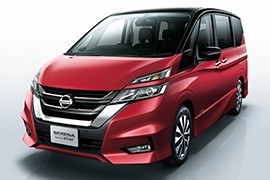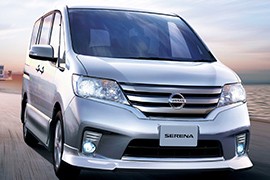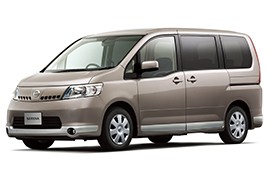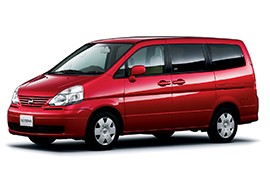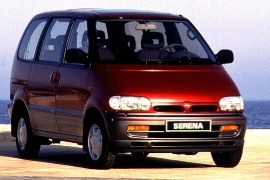NISSAN Serena Models/Series Timeline, Specifications & Photos
First production year: 1991
Engines: Mild hybrid, Gasoline, Diesel
Body style: Van
The Nissan Serena began its production in 1991 and started off as a compact passenger minivan. The van's size increased during the following generations.
In 2016, Nissan unveiled the fifth generation of the model. The biggest feature added was Nissan's ProPilot technology, an advanced driver assistance system designed for highway use. The technology was developed to maintain the car's lane position and distance from the vehicle in front.
The interior became more spacious and the wheelbase was extended by 180 mm. New features were included to increase the ease of use. The sliding doors can easily be opened by sliding your foot under the door, so that you wouldn't need to use your hands.
While still keeping some design details of the previous Serena model, the 2016 has a more dynamic and refined look: a refreshed front grille, a floating roof design and 13-color availability, including a new two-tone design.
Other significant features include a 6-port USB power socket, Zero Gravity seats with spinal support, a large 7-inch display and a capless fuel filler. The cabin's quietness was improved and the model's handling was upgraded as well, especially at low speeds.
The car is equipped with an automatic parking assist system, a smart rearview mirror and an Around View Monitor that provides a virtual 360-degree scene. Nissan provided important safety features such as Forward Emergency Braking, Emergency Assist and Lane Departure Warning. Lots of other key safety and environmental features are available.
The fourth generation of the Nissan Serena was introduced in late 2010 in Japan and in 2011 on other markets.
The 2010 Serena introduced an important change in the model's history lineup. It was the first generation powered by a hybrid powertrain. The large MPV proved itself very useful as a vehicle for big families and as a shuttle.
While its exterior dimensions were slightly increased compared to its predecessor, the 2010 model featured the same wheelbase. Even the design was similar to the third generation, which was introduced in 2005. Its design resembled the one of an LCV, with wide power-sliding doors in the back and a big liftgate in the rear. At the front, the big chromed grille and the sporty-looking apron made the MPV more appealing. It was offered in two length versions to accommodate a bigger luggage compartment.
Inside, the Serena could transport up to eight occupants, depending on the seating configuration. There were three rows of seats, with plenty of room for all of them. In the back, the bench was retractable on the side panels while the second row could have been folded, transforming the car into a large furniture carrier.
The first-ever Nissan hybrid MPV offered a choice of two power outputs. The gasoline unit was a 2.0-liter four-pot engine and paired to an electric motor and a CVT transmission.
The third generation of the Serena was introduced to the Japanese market in 2005, while on other markets, the second generation of the Serena was still on the market.
Nissan and Suzuki made a deal to develop and build a few vehicles together. Among them, it was the Nissan Serena/Suzuki Landy duo. With their power combined, the results were remarkable, and the Serena succeeded to be the most sold MPV on the Japanese market in 2007, 2008, and 2009. The car was built with top safety systems and a large interior, fit for up to eight passengers.
From the outside, Serena's headlights featured a similar design to those installed on the Nissan Patrol. Unlike many other MPVs on the market, it featured an ascending step on the front doors' beltline. The sliding rear side doors made room for easier access to the middle and the rear seats. In the rear, the vertically mounted taillights on the D-pillars made room for a wide tailgate.
Inside, the carmaker installed a pair of tall seats at the front, with a gear selector mounted high, on the center stack. The instrument cluster and the infotainment unit were similar to those installed on the Nissan Primera. But it was difficult to hide the car's LCV origins.
Nissan offered only one engine option for the Serena, a 2.0-liter naturally aspirated unit paired to a CVT gearbox named X-Tronic. The car was available with either a front- or all-wheel-drive.
Nissan built its brand awareness on the utility vehicle segment's backbone, where it succeeded in offering dependable vehicles for contractors and construction sites.
While the first generation was trustworthy, reliable, and affordable, its design was dull and unconvincing. That wasn't a real problem for a utility vehicle, but the sales departments noticed that critic from customers and asked for a better-looking car. That didn't come until the second generation, in 1999, which was also offered as a minivan for selected markets.
The vehicle's raked front side made it look more like an MPV, even if under its new body was still a ladder-frame chassis built to carry heavy loads on various terrains. The contemporary front design with a large front grille and four headlights enhanced the exterior look. Its dual sliding doors on the sides made easier access to the cabin. The pillar-mounted taillights were big and mounted upper in the rear to be protected from parking scratches.
Inside, Nissan offered the Serena seating for up to seven passengers, but a more luxurious version with fewer seats was available. The carmaker installed the gear selector on the dashboard next to the steering wheel to clear-up the floor between the front passengers.
Under the hood, Nissan placed a 2.0-liter gasoline engine paired to a CVT gearbox. It used the same transmission for the 2.5-liter diesel version, which was available on selected markets.
Nissan cut a set of windows into the panels of a Vanette, transformed it into a people carrier, and named it Serena.
It wasn't unusual for a carmaker to convert a van into a minivan. Volkswagen, Chrysler, Ford, and PSA did it, to name just a few. So why wouldn't Nissan follow the same recipe? It did it, and it did a good job if the owner was never in a hurry. The Serena was launched in 1991, and it was a unique presence on the road due to its unusual concept. Unlike other minivans from its segment, it wasn't a front-engine and front-wheel-drive. It was a mid-engine and rear-wheel drive.
The car's exterior couldn't hide the fact that it was a light commercial vehicle transformed into a minivan. Its short and steep front end was good for an LCV driver to stop as close as possible behind the car in the front. Its sliding door on the passenger side was large enough to be loaded with a forklift. It was a tall vehicle with a liftgate in the back. As an option, Nissan added a second sliding door on the driver's side.
Inside, everything was covered in cheap-looking plastic. The front seats were separated by the engine cover under the floor behind the front axle. In the back, the carmaker added a bench and a pair of side-mounted jump-seats. As an option, later on, Nissan installed tree rows of seats when the side-mounted jump-seats were not allowed anymore.
Nissan offered the Serena a choice of gasoline, diesel, or turbo-diesel engines ranging between 75 hp and 140 hp. One of the most common versions for the European Serena was the naturally aspirated 2.3-liter unit, which was not available in Japan.
